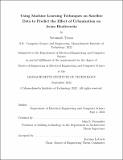Using Machine Learning Techniques on Satellite Data to Predict the Effect of Urbanization on Avian Biodiversity
Author(s)
Tynan, Savannah
DownloadThesis PDF (2.579Mb)
Advisor
Fernandez, John E.
Terms of use
Metadata
Show full item recordAbstract
Assessing the relationship between environmental and socio-economic conditions of an urban area and local urban biodiversity loss is integral to informing policy decisions, urban design, and community action plans.
Though some previous research explores the relationship between urban areas and biodiversity loss, the limited available studies are often specific to only one city or region. Those that do model this phenomena in multiple cities are limited to environmental variables, and rarely examine the socio-economic conditions of a city, such as average GDP or population density. To our knowledge, no studies analyze the complex underlying relationship between socio-economic as well as environmental conditions within urban areas and biodiversity, which is necessary for strategically protecting the most at risk regions.
This work aims to leverage satellite datasets to predict cities’ risk exposure for bird biodiversity loss. This research aspires to develop an analytical approach that can be used for various types of biodiversity, though we restrict our initial analysis to birds, as they offer a broad range of data and can be used as an indicator for other species.1 We aim for our approach to be applicable to all urban areas, so this research leverages a globally representative sample of cities with robust survey data. The over-arching goal of this project is to design a methodology to better advise resource allocation for the protection of global biodiversity.
We process 9 publicly available satellite datasets to create environmental and socio-economic features for every functional urban area (FUA), as classified by the OECD, totalling over 9,000 FUAs. We train and test 3 models: linear regression, random forest regression, and a hybrid supervised and unsupervised model. We analyze the predictive power of these approaches as well as relative importance assigned to each input feature. We find that all 3 of the approaches have the ability to accurately predict biodiversity loss and all of them find that the maximum land modification value of each FUA is the most useful feature in determining biodiversity loss. Finally, we discuss the implications of these findings and our models ability to inform resource allocation.
Date issued
2022-09Department
Massachusetts Institute of Technology. Department of Electrical Engineering and Computer SciencePublisher
Massachusetts Institute of Technology